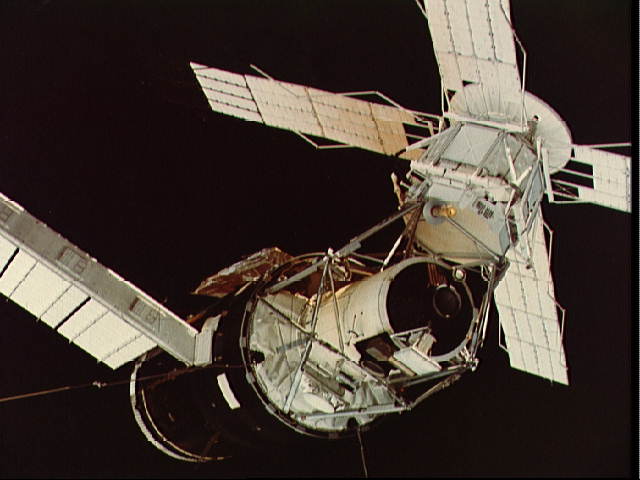
Forty years ago this summer, America’s first space station—Skylab—was boosted into orbit atop the last in a generation of mighty Saturn V rockets. During launch, however, disaster struck the mission, when the station’s micrometeoroid shield and one of its electricity-generating solar arrays were torn away in the aerodynamic slipstream and the first crew were faced with enormous difficulty to turning Skylab from a barely habitable hulk into their home for a month. They returned to Earth in late June 1973, leaving a vastly improved station for the next crew. On the second mission, Skylab 3, astronauts Al Bean, Owen Garriott, and Jack Lousma were tasked to spend a record-setting 59 days in orbit, more than twice as long as had been accomplished by any previous astronaut or cosmonaut. The mission would prove an enormous success … but that success could hardly have been imagined during Skylab 3’s first few unfortunate days.
Everything seemed to be looking up for Bean, Garriott, and Lousma. On 20 July, a week before launch, their mission was extended in length from 56 to 59 days to provide a better recovery posture for their scheduled return to Earth and splashdown in late September. One of the biggest worries facing the new crew was the health of Skylab’s stabilizing rate gyroscopes, needed for orientation, and the possible deterioration of a makeshift “parasol,” fitted by the first crew. For its part, NASA was so keen to get Bean and his men aboard the station as quickly as possible that on 6 June—while the first crew were still in residence—the launch of the second mission was advanced a week from early August to 27 July, with an option to fly on the 22nd if the situation worsened.
As these plans crystallised, the Saturn IB rocket and the attached command and service modules were rolled out to the Kennedy Space Center’s Pad 39B on 11 June. A series of inauspicious lightning strikes on the launch tower raised a few eyebrows, but the damaged parts—including spacecraft instrumentation—were replaced and retested. The countdown commenced on the morning of 25 July, with launch set to occur at the start of a ten-minute “window,” opening at 7:08 a.m. EDT on the 28th.
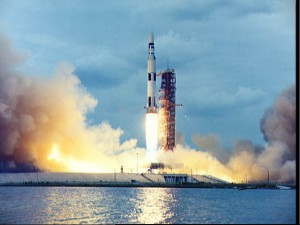
In orbit, Skylab had been carefully depressurized and its internal temperature was kept at a controlled level to prevent condensation whilst unoccupied. Solar observations were also pursued, autonomously, using the Apollo Telescope Mount (ATM), although this work was suspended following the failure, on 19 July, of a primary rate gyroscope—one of the nine electronic instruments used to provide primary and backup control of the station’s orientation in the roll, pitch, and yaw axes. Four days later, NASA announced that Bean’s crew would carry a “six-pack” of replacement gyros (properly termed a “rate gyro augmentation package”) to provide redundancy for both their mission and that of the final crew.
“At present,” NASA reported, “one [gyro] has been turned off because it malfunctioned, while five others have overheated to some degree at one time or another during more than two months the spacecraft has been in orbit.” The news release cautioned that an actual replacement would probably not happen unless all three gyros failed in one axis, requiring approximately 20 minutes of EVA time. Also aboard the command module was an improved parasol. The astronauts had trained extensively to install both this and the Marshall Space Flight Center’s twin-pole thermal shield, which had been developed in May to provide backup micrometeoroid protection and supplement the parasol and had been taken to the station by the first crew, but not deployed.
Twenty hours before the crew was set to lift off, Skylab’s atmosphere was repressurized, in anticipation of the arrival of its second team of human visitors. Despite its very long duration, Bean’s mission would be packed to the rafters with scientific and engineering objectives: a preliminary timeline, released by NASA on 12 July, highlighted plans for an EVA on the 31st, in which film canisters would be loaded for the ATM and the twin-pole sunshade would be installed. Two more excursions were also scheduled for 24 August and 19 September for the purposes of retrieving and installing more ATM film.
If Skylab was ready for an influx of new arrivals, then the Kennedy Space Center was equally ready and received its own fair share of visitors on the day of launch, with no fewer than 35,000 people cramming the press site, public viewing areas, and causeways, excited by the drama of the last several weeks and eager to observe the next part of the adventure. The morning of 28 July dawned dreary and overcast, evidenced by NASA television footage from the day, with only a few lights in the vicinity of the pad twinkling through the gloom and illuminating the ghost-like shape of the Saturn IB.
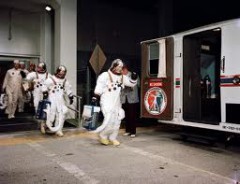
Aboard the command module, Bean was positioned on the left, with science pilot Garriott in the centre seat and pilot Lousma over on the right. During training, they had convinced themselves that all three of them came from the U.S. Navy—Bean was an active captain in the service, Lousma a major in the Marines (which “really is just a subset of the Navy,” according to Garriott), and the science pilot himself was a veteran of three years of naval duty in his younger days. “My total time in the military,” Garriott acquiesced, “hardly compared to the career that both Alan and Jack have, but that was a minor unifying factor and we had a chance to joke about it from time to time.”
By the time he ascended the tower to Pad 39B for his first launch into space, Garriott had been training almost exclusively on Skylab for more than five years and knew his two crewmates not only as colleagues, but as friends. All too often, the perception of Garriott as the “science pilot” on the mission has led many observers to assume that the duties of his colleagues were exclusively piloting or engineering roles. The reality was that all three men were cross-trained and each was as competent and internally motivated as the others to accomplish Skylab’s scientific objectives. Their deep-seated friendship persisted and, even three decades after their mission, they took family holidays together.
When the astronauts arrived at the pad for their launch into space, Lousma still had to pinch himself. Clambering into the transfer van in his bulky space suit and oxygen hoses, he had to constantly remind himself that this was not a simulation or a drill; it was the real thing. The flashlights of the assembled press were for real, as were the checkpoints, the last-minute examinations by the flight surgeon, the traditional astronaut’s breakfast of steak and eggs, the sticking of biomedical electrodes to their chests, and the pressure checks of their space suits. “The technicians … weren’t saying much of anything,” Lousma recalled in his NASA oral history, “because I think they were afraid they would disturb you. You could tell that they knew that this was the moment of truth, and it was quite clear that this was the day we were all waiting for.”
Out on the gantry of Pad 39B, awaiting his turn to board the command module, Lousma noticed that the normal beehive of activity and the dozens of hard-hatted technicians who normally swarmed around were conspicuously absent; the launch complex was eerily quiet, with hardly any sound, save for the hissing airflow inside his helmet. “Boy, this was the absolute 2001 experience,” Lousma said. “This was really spacy.” As the science pilot, occupant of the command module’s centre seat, Garriott was the last to enter and had a few moments of private reflection, gazing across the slumbering Florida landscape. “There was a long training period leading up to this moment,” he recalled. “A fiery rocket would soon take our speed from zero to over five miles a second … in less than ten minutes!”
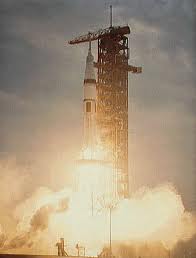
From the press site, several kilometres away, CBS anchorman Morton Dean was relaying live commentary to his audience. Next to him sat former Apollo astronaut Wally Schirra, now the network’s “special expert consultant.”
“T minus 40 seconds,” Dean intoned, as television images showed the Saturn IB, scarcely visible against the murk of the early morning. A few twinkling searchlights glimmered through the pre-dawn gloom. “The spacecraft commander has now made the final guidance alignment,” he continued. “That’s the final action to be taken by the crew on-board the spacecraft until after the launch. T minus 30 seconds … the eight first-stage engines will ignite at 3.1 seconds in our countdown. They’ll be held down while thrust is built up at the zero mark, at which time we’ll get liftoff.”
Morton Dean’s voice notched up an octave as he prepared his audience for the big event and those final few seconds before the Saturn was set to shear its manacles and tear itself loose from Earth: “T minus ten, nine, eight, seven, six, five, four”—then a tongue of bright orange flame, which steadily thickened and expanded into a vast, blinding sheet, erupted from the base of the booster and licked at the metallic trusses of the rocket’s supporting milk stool—“three, two, we have ignition sequence start, all engines are running”—as the eight H-1 engines roared to near-full power, almost obscuring the rocket from view with their glare—“we have a liftoff … and the second manned crew has cleared the tower!”
As the Saturn rose into the overcast sky and quickly vanished into a deck of gloomy, lowering cloud, Dean turned to Schirra and chattered over the airwaves about his impressions of the launch: the rolling thunder and pulsations of sheer naked energy which now pummelled their bodies.
From his couch on the right side of the command module, Lousma noticed a very definite “heavy vibration” at the instant of liftoff. This sensation very quickly damped out, but the initial “chugging” of the Saturn IB did little to disguise the tremendous acceleration, which peaked at around four and a half times the force of gravity. As the S-IB first stage expended its load of propellant and separated, the three men were greeted by an eerie, though temporary, silence, as they coasted for a while, interrupted by the detonations of explosive charges, then the seat-of-the-pants push as the single J-2 engine of the S-IVB took over and continued the boost into orbit. Through the window, Lousma vividly remembered seeing a vast, circular “fan” of debris, flying outwards in all directions and glinting in the sunlight. For Owen Garriott, the sensation of being pressed into his seat at several times his Earthly weight to suddenly floating in his harness was electrifying.
Ten minutes after leaving Florida, the second Skylab crew were in space, primed for an eight-hour chase of Skylab and a late-afternoon rendezvous and docking. Also hitching a ride to their new orbital home was one of the largest “crews” ever launched; for in addition to Bean, Garriott, and Lousma, a complement of almost 800 living creatures were packed into various nooks and crannies and lockers and containers within the command module. Their purpose was to permit researchers to analyse circadian rhythms and closely monitor how they would cope and adapt to the strange weightless environment. The astronauts would share their home with two common cross spiders (Araneus diadematus), named Anita and Arabella, together with a pair of brackish water minnows (colloquially known as “Mummichogs”) and 50 of their eggs, half a dozen pocket mice from the deserts around Palm Springs, Calif., and 720 vinegar gnat pupae.
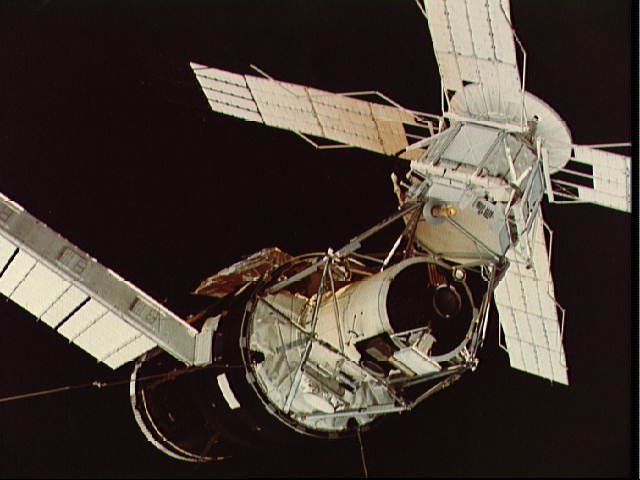
The fish, NASA revealed, had been added to the list at Garriott’s request and were caught in the coastal waters near Beaufort in North Carolina. Their presence in a specially-built aquarium was part of vestibular studies into the possible disorientating effect of weightlessness, whilst Anita and Arabella—part of a student experiment proposed by 17-year-old Judith Miles—would be monitored to assess their ability to build webs in conditions utterly peculiar to those in which their species had evolved. Lastly, the mice and gnats were kept in a compartment aboard the service module and were part of investigations into changes of circadian rhythms.
In spite of a seemingly perfect launch and insertion into orbit, problems did not take long to catch up with the crew. About three hours after leaving Cape Canaveral, midway through their orbital ballet to rendezvous with Skylab, Bean reported what he described as “some kind of sparklers” streaming past one of the command module’s windows after the first firing of the big Service Propulsion System (SPS) engine. Lousma had spotted it first and called Garriott to his window on the right side of the spacecraft to take a look. “I looked out his window,” Garriott recalled, “and here came what looked to be the nozzle of one of the reaction control thrusters just floating by the window! It couldn’t have come off the spacecraft … the propellant line to that nozzle had sprung a leak, so when the propellant comes out of the fuel line, it then freezes on the nozzle and then after a certain amount of it escapes, it acquired the shape of the nozzle. What floated away was an ice sculpture of that reaction control thruster!”
A few seconds later, Bean was startled by the blaring of a master alarm, which indicated low temperatures in one of the ship’s Reaction Control System (RCS) thruster quads. And at this stage, the problems of Skylab 3 really began to take hold.
The second part of this article will appear tomorrow.
Want to keep up-to-date with all things space? Be sure to “Like” AmericaSpace on Facebook and follow us on Twitter:@AmericaSpace



